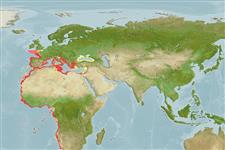Élasmobranches (requins et raies) (sharks and rays) >
Squaliformes (Sleeper and dogfish sharks) >
Squalidae (Dogfish sharks)
Etymology: Squalus: Genus name from Latin 'squalus' meaning shark (Ref. 6885, 27436).
More on author: Risso.
Environment: milieu / climate zone / depth range / distribution range
Écologie
marin; saumâtre démersal; profondeur 15 - 1500 m (Ref. 125614). Subtropical; 11°C - 18°C (Ref. 54892); 50°N - 37°S, 20°W - 38°E (Ref. 54892)
Eastern Atlantic: Bay of Biscay to Mediterranean, Morocco, Senegal to Namibia (these records may include other species in addition to Squalus blainvillei). Although reported from the Canary Islands (e.g. Ref. 247), it is most likely based on misidentifications of Squalus megalops (Ref. 6808). Western Pacific: southern Japan and Taiwan. Nominal records of Squalus blainville or Squalus fernandinus from the western Atlantic (North Carolina, USA to northern Gulf of Mexico; Argentina), Indian Ocean (South Africa, Mozambique, Madagascar, Tanzania and India) and the Pacific (Australia, New Zealand, New Caledonia, Hawaii and northern Chile), as well as some records from the northwest Pacific and eastern Atlantic are based at least in part on Squalus mitsukurii and possibly other species. Whether Squalus blainville itself is as wide-ranging as reported for blainville-group dogfishes (including Squalus mitsukurii) remains to be determined.
Length at first maturity / Taille / Poids / Âge
Maturity: Lm 57.1, range 57 - 58 cm
Max length : 122 cm TL mâle / non sexé; (Ref. 86318); 117.5 cm TL (female); poids max. publié: 7.3 kg (Ref. 86318)
Found on the continental shelves and upper slopes. Depth range from 16-440 m (Ref. 0247), and from 300-780m in the eastern Ionian Sea (Ref. 56504). Forms schools. Off West Africa, water temperature and salinity where this species is often found ranges from 11-18°C and 36 ppt. (at 16 to 255 m depth), respectively. Feeds on bony fishes, like denticids, mackerel and percichthyids, as well as crabs, lobsters, and octopi. Ovoviviparous, with 3 to 4 young per litter. Utilized fresh, dried salted and smoked for human consumption.
Distinct pairing with embrace (Ref. 205). Ovoviviparous, with 3 to 4 young per litter. Young born at about 23 cm (Ref. 247).
Compagno, L.J.V., 1984. FAO Species Catalogue. Vol. 4. Sharks of the world. An annotated and illustrated catalogue of shark species known to date. Part 1 - Hexanchiformes to Lamniformes. FAO Fish. Synop. 125(4/1):1-249. Rome, FAO. (Ref. 247)
Statut dans la liste rouge de l'IUCN (Ref. 130435)
Menace pour l'homme
Harmless
Utilisations par l'homme
Pêcheries: commercial
Plus d'informations
RéférencesAquacultureProfil d'aquacultureSouchesGénétiqueElectrophoresesHéritabilitéPathologiesTraitementNutrientsMass conversion
CollaborateursImagesStamps, Coins Misc.SonsCiguateraVitesseType de nageSurface branchialeOtolithesCerveauxVision
Outils
Articles particuliers
Télécharger en XML
Sources Internet
Estimates based on models
Preferred temperature (Ref.
123201): 10.3 - 15.6, mean 13.4 °C (based on 273 cells).
Phylogenetic diversity index (Ref.
82804): PD
50 = 0.5000 [Uniqueness, from 0.5 = low to 2.0 = high].
Bayesian length-weight: a=0.00324 (0.00271 - 0.00387), b=3.06 (3.01 - 3.11), in cm total length, based on LWR estimates for this species (Ref.
93245).
Niveau trophique (Ref.
69278): 4.0 ±0.4 se; based on diet studies.
Résilience (Ref.
120179): Très faible, temps minimum de doublement de population supérieur à 14 ans (K=0.10-0.14; Fec=3).
Fishing Vulnerability (Ref.
59153): High to very high vulnerability (68 of 100).
Nutrients (Ref.
124155): Calcium = 20.2 [4.1, 89.6] mg/100g; Iron = 0.642 [0.164, 1.857] mg/100g; Protein = 19.2 [17.4, 20.8] %; Omega3 = 0.436 [0.168, 1.157] g/100g; Selenium = 32.8 [10.3, 89.8] μg/100g; VitaminA = 8.6 [3.3, 23.0] μg/100g; Zinc = 0.618 [0.309, 1.173] mg/100g (wet weight);
